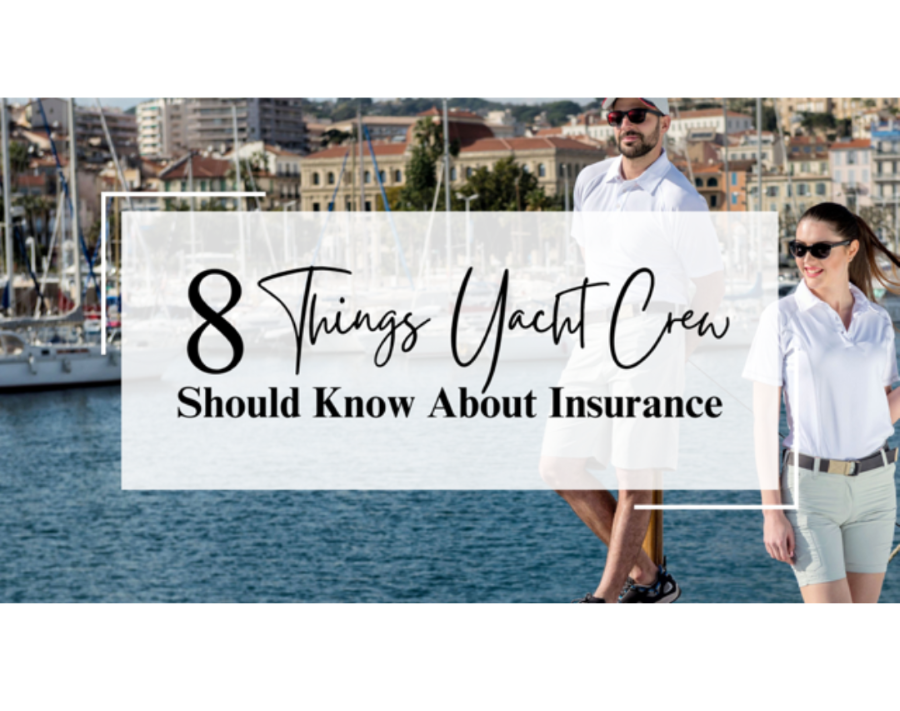Written by Melanie Langley and Marién Sarriera
Marién, the founder of Yachts Mermaids and a former yacht crew member with over 15 years at sea, knows how frustrating, challenging, and daunting the topic of insurance can be. This is why she has partnered with Melanie Langley, a maritime insurance broker at Moore Dixon (MDBL), well-known for its ACREW Superyacht Business Awards (Best Insurance Health & Medical and Best Service Provider Finalist). In order for you to understand how maritime insurance works onboard yachts and how to be covered as a seafarer when the unexpected happens, below we have listed 8 things you should know about yacht crew insurance.
1. Understand what insurance is
It’s essential to understand insurance when discussing it. Insurance is a contract (called an insurance policy) in which, for a set sum (premium), you receive financial protection or reimbursement against losses from the insurance company. These potential losses are set out in the policy contract.
2. Know who’s in charge of supplying insurance onboard
Usually, your employer purchases the insurance for the crew as a group, and the management company helps with claims. In other cases, you must purchase your insurance, and the vessel will refund you a monthly set amount stipulated in the contract. Sometimes, the Captain, Purser, or HOD may oversee crew insurance and can advise you if you need help with your claims. We recommend finding out who supplies the insurance, who the point of contact is, and how to make a claim.

3. Difference between P&I and medical insurance
P&I (called Protection and Indemnity Insurance) is a type of insurance that yacht owners purchase to cover the potentially huge costs of any harm they accidentally cause to people, property, or the environment. Medical insurance is specifically designed to look after any illnesses or injuries you may have. Your medical insurance type may vary widely; some cover preventative checks, and some just cover emergencies.
Most P&I insurance policies require medical insurance to be in place before they will offer any coverage. So, with a medical claim, the medical insurer is the first to respond financially. It is also worth noting that most P&I claims must be work-related.
If medical insurance is provided, it would cover medical costs only. Depending on the severity of the injury, there could also be a potential claim for permanent disablement via the P&I policy. Some yachts also have additional personal accident insurance, which means your salary would be covered if you are injured while working. Again, this is why you must find out what coverage is provided onboard.
Moore Dixon Brokers Limited does cover both groups and individuals for personal accident cover, so even if your yacht doesn’t provide this, you can still get it and protect your salary. Click here to learn more.

4. MLC flag states insurance coverage vs. other flag states
Richard Johnson-Brown from Keystone Law shared that the MLC 2006 (Maritime Labour Convention) requires health insurance for all seafarers working on board commercial and private yachts that are part of the convention.
MLC does not directly apply to yachts flagged in states that have not ratified it, such as the United States of America. But if your country of residency has ratified the MLC 2006, this could mean that the MLC 2006 standards on board ships, as implemented nationally, would also apply to protect you. This information can be found in Article V, paragraph 7, of the MLC 2006.
“So, in effect, while health insurance is not a requirement for yachts flagged in non-MLC flag states, an MLC flag state/country may nevertheless require the yacht’s seafarers to have health insurance if they call at the state’s ports (the extent to which this is enforced depends on each individual MLC flag state and their PSC).”
To expand on the USA insurance requirements, as it is not an MLC signatory and does not have to comply, Oleg Otten, Michael Karcher, and Roberto Rodriguez Allen from Robert Allen Law shared with us that the USA has its own legislation called The Jones Act, which ultimately gives the employer a duty of care for their crew.
“The USA did not ratify the MLC, and the USA has no legislature comparable to the MLC. There are some relevant USA employment laws (for example, laws against discrimination) and case laws on seamanship rights, which all employers should follow in the USA. But beyond that, the key document is the employment agreement (SEA)/contract.
There is no legal requirement to provide health insurance, regardless of tonnage or registration. The legal requirement kicks in only when and if a crew member is injured while serving on the vessel, and it applies to “maintenance and cure” referenced below.

The traditional remedies of Maintenance and Cure provide an employee (crew member) of a seagoing vessel with a daily living allowance designed to cover food and lodging (Maintenance) in addition to actual payments for therapeutic, medical, or hospital expenses (Cure) during periods of illness or injury while the employee is in the service of the ship. The right to such benefits “extends during the period when [he or she] is incapacitated to do a seaman’s work and continues until he or she reaches maximum medical recovery.
The “Cure” doctrine requires the vessel owner to pay for the seaman’s medical treatment until the seaman reaches “maximum medical cure.” Maintenance is supposed to give the seaman the wages he or she would have earned to the end of the voyage and enough compensation to provide the seaman with room and board comparable to that offered on the vessel. However, seamen are entitled to maintenance payments even if they did not live or sleep aboard the vessel.
Under most circumstances, if a seaman is injured or falls ill while “in the service of the vessel,” the employer must pay maintenance and cure even if the employer was not at fault, or sometimes even when the illness or injury is unrelated to your employment.
A seaman also has the right to sue his or her employer for negligence under the Jones Act, 46 U.S.C. § 30104, in addition to the claim for maintenance and cure. Damages for negligence can include pain and suffering, loss of earnings, future medical expenses, and the inability to enjoy life. This requires a showing of negligence by the seaman’s employer.
That said, while there may not be a specific legal requirement for health insurance coverage for crew members, it is common practice and advisable for yacht owners to provide insurance coverage for their crew as part of their employment benefits package. This can include health insurance and other types of insurance, such as workers’ compensation and liability insurance.”

5. Be informed about Death and Disability coverages
If you were to pass away or experience a permanent disability, would you be protected? Finding out if the vessel has a Death and Disability coverage is crucial information you should know. Again, from boat to boat, this will differ. That’s why we highly recommend you always have this type of insurance as personal coverage. It’s important to remember that standard insurance from your home country might consider yachting a ‘dangerous’ occupation and not cover you. So, it’s worth going to a seafarer-specific insurance provider like MDBL to support your scouting for coverage at sea.
6. The most essential coverage for yacht crew
Medical insurance is the single most important insurance for a crew member working on a yacht. This is mainly because you will be working in different countries with distinct health systems than your country of residency, where you may have some level of coverage in public health service or a local policy. This becomes even more essential if you are working in the USA/Canadian waters, as the medical bills in these countries are likely to give you nightmares!

7. When to get insured
The time to get your personal insurance is NOW, even if you think you don’t need it. It is essential to know that the healthier you are, the easier it will be to get coverage, as sometimes it’s too late to obtain personal medical insurance when you already have a pre-existing medical condition. The insurer may either exclude the condition, place a loading (extra cost), or, in some instances, choose not to offer you cover. If your boat doesn’t provide cover, get it yourself.
Freelance and yacht crew between jobs must get themselves protection through coverage. It’s too easy to think it won’t happen to you, but unexpected health issues, accidents, death, and disability do happen to crew just like you. How often have you seen a donation campaign for the crew that thought it couldn’t happen to them?
8. How to get insured
Only a few companies offer individual plans for yacht crew, but many offer group policies. If you want to discuss your options for individual or group policies, I highly recommend contacting Melanie Langley from Moore Dixon Brokers Limited.
You can contact her at melanie.langley@mooredixon.com
We hope these eight tips have clarified and given you important insights about seafarers’ insurance on yachts. Download the Yachts Mermaids Basic Seafarer Rights Guide to continue your seafarer rights education.

Special thanks to Richard Johnson-Brown from Keystone Law for his valued input regarding MLC 2006 and to Oleg Otten, Michael Karcher, and Roberto Rodriguez Allen from Robert Allen Law for their excellent and detailed explanation of U.S.A maritime employment law.
Melanie Langley is a Director at Moore Dixon Brokers Limited. She has been with Moore Dixon for 13 years, previously based in Palma, Mallorca, and now based back in the U.K., in Somerset. She is a member of the Chartered Institute of Insurers. Contact Melanie at Melanie.Langley@mooredixon.com
Marién Sarriera is a former Chief Stew with over 15 years at sea and founder of Yachts Mermaids, a platform that provides resources, tools, and support for yacht crew. She is also a human rights advocate for seafarers. Through her Uncensored show via Yachting International Radio, maritime staff can have their voice heard to empower and inform others about their rights, equality, social justice, inclusion, mental health, and how to create a safer work environment to work in. You can watch or listen to it here.

